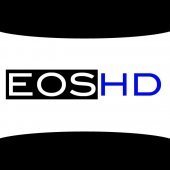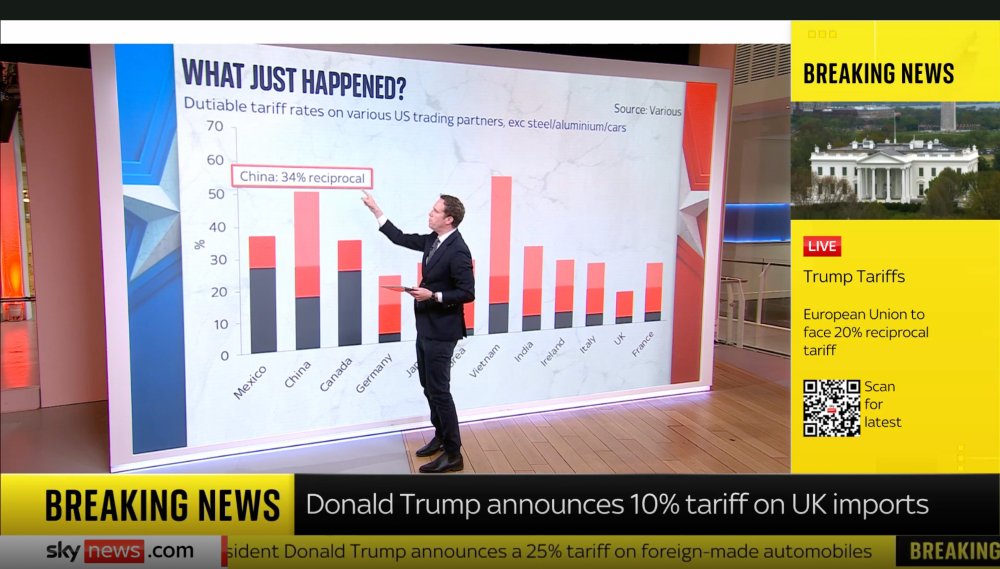-
Posts
15,624 -
Joined
-
Last visited
Content Type
Profiles
Forums
Articles
Everything posted by Andrew - EOSHD
-
I agree but it's hard to reason with someone with an IQ of 80...And there's a lot of them. If the hatred for guys like Biden runs so deep with half the country, again a wake-up call is deserved and well overdue in the form of 30% inflation which Biden had at 2.9% but Trump will turn up to catastrophic house repossession causing figures.
-
The numbers are based on some crazy ideas. To name but one tiny example... If a country imports diamonds to the US and that trade amounts to more than that sum total that country buys in turn from the US this has been factored into the sums. Does Trump expect the US to suddenly conjure up a diamond industry... and coffee, and so on. Stuff which literally doesn't exist or doesn't grow, at least in the quantities they need. The impact on inflation in the US is going to be staggering, and that African country with the big exports will simply sell the diamonds to somewhere else and the US will have achieved nothing. In terms of electronics, even if they make the shit in Texas they still need the raw resources. Plus the impact of US wages on a factory the size needed to satisfy the US market for phones alone is staggering. The product will cost an incredible amount more. Does he also expect the Japanese camera industry to uproot from Asia and plant itself on his doorstep? It's completely unrealistic to do and undesirable for US consumers even if it happens as the prices will have to go up by 3-5x or more to pay the workers US wages. Anyone still under the magic spell of nationalism thinking Trump is so great is about to get a massive fucking wake up call when they look at their bank account.
-
It's actually worse. Over 50% on China in sum total of all Trump's tariffs. If you voted for this and think it's a good idea you need your head examined.
-

Adolescence on Netflix: Technique & Creativity
Andrew - EOSHD replied to Davide DB's topic in Cameras
I think it's a compromise but far better to have the one-take per episode than the usual cutting. There's nothing natural about cutting really. Our eyes don't do it. If anything, the slow panning between actors replicates our mind tuning into one person over the other at various times, and we do that in real life quite a bit. -

Blackmagic NAB 2025 Preview - 4th April 2025 4pm BST
Andrew - EOSHD replied to BTM_Pix's topic in Cameras
I'd like a consumer camera from them, under $1k. They've done enough pro stuff now, big and heavy stuff, sensor in a box, you name it. But there's no small camera with autofocus and IBIS. Blackmagic could add in their unique features and it would rule. Internal BRAW + ND + their image quality all in a consumer friendly mirrorless camera form factor with similar build quality to Fuji. I also think they should do a modern spin on the original BMCC 2.5K. The Cinema DNG image from that was cinema on a stick. If only they'd do a new version with the same or similar sensor, with autofocus, IBIS, and an EVF, plus small, interchangeable battery + CFexpress slot all for under $2k. We'd finally have that next Digital Bolex type camera. -
The main camera manufacturing countries just got slapped by Tango-man. China - 34% Vietnam - 46% Taiwan - 32% Japan - 24% Thailand - 36% Hope all the ones who voted for this enjoy their new electronics prices 👍
-
The plan is to launch it in Tokyo and invite everyone over to see the S9 Barbie Edition (China only)
-

Need to vent... MPB are a f-ing nightmare
Andrew - EOSHD replied to Andrew - EOSHD's topic in Cameras
Good luck. If things go well it's gravy with them. If not... Lap of the gods my friend. -

Adolescence on Netflix: Technique & Creativity
Andrew - EOSHD replied to Davide DB's topic in Cameras
Just watched the first episode. Very good stuff. The single take is extraordinary but almost seamlessly unnoticed at same time. -

Need to vent... MPB are a f-ing nightmare
Andrew - EOSHD replied to Andrew - EOSHD's topic in Cameras
Update: They lost another one. Leica Q ordered 20th March, never turned up. Tracking with DHL stopped updating at same point as last time, at the sorting centre outside of Berlin. The goods have vanished into thin air. That's over £2000 of losses with no explanation. They are now putting it right in terms of refunds, and Matt the CEO is involved. They also had an Sony A7S III on the UK site, spares and repairs for £1399 as the bluetooth / wifi was faulty, but since I don't care for that and thought it might even be fixable completely I thought I'd grabbed a bargain. So I booked it out as part of a trade in. This reserves the item for 14 days. Before I had chance to send in the trade-in camera the A7S III was apparently un-booked with no email or notification, and sold to someone else instead. At this point it feels personal? -
Wait 7 years
-
R = stills and video, emphasis on photography V = lower priced content creator hybrid with emphasis on video C = high-end cinema / film-making tools The R5 II sensor will going in the EOS R5 C II So I now think the EOS R5 V will in fact be an R6 V or R8 V with the R6 II sensor and a more video / youtube friendly design.
-
My Sony RX1R had developed some coating marks on the screen. Turns out it just peels off to reveal a pristine glass LCD underneath. Indeed the upper layer is a factory-installed layer of anti-reflective plastic! Daft decision from Sony and effects a lot of models... But at least now if it happens to you, you know what to do.
-
"We make so few of them, they'd sell out even in Greenland alone"
-
Have they thought of a new line because this one's getting old.
-
I think people should show us the magic sauce. It's hard to judge through YouTube commercials.
-
He switched to Sony. A full frame R5 V is what we really want, around the $2000 mark.
-
The EOS R50 V is a loss leader out to encourage lens sales with a huge army of social media influencers and Youtubers. On the face of it, it's definitely a step forward from Canon in the value for money stakes. Sure, they will want you to buy loads of expensive glass for it. Thankfully Sigma is doing some nifty APS-C lenses so we don't have to. I do like the built in LUTs, C-LOG3, AF should be decent although maybe perfect, but it does lack an EVF and IBIS.
-
Better not get too carried away with the pretty Canon logo. I mean it may be cheap but it's still shitter than a 6 or 7 year old camera isn't it? I mean you can get a Fuji X-T3 with the advantage of no crop in 4K/60p, more codec options and an EVF for the same price.
-
https://bylinetimes.com/2025/02/21/donald-trump-was-recruited-by-the-kgb-under-codename-krasnov-claims-former-soviet-spy-chief/
-
$3k is a good price but it might be more interesting to wait it out and see what Nikon mirrorless camera gets Redcode. As for global shutter vs rolling shutter... 4ms vs global shutter is probably not going to be very noticeable. The Fuji X-H2S is doing 9ms in 4K and 4ms in 4K/120p and it costs $1500 on eBay. Show us 🙂
-
How about a fat fucking cunt named Donald. Would make a great soviet villain.
-
Apparently it has a fan. It's a keen price... $695 I quite like it but never going to be groundbreaking coming from them
-
Yes but I don't quite see the point of it Is the codec better than N-RAW? I'd say yes from a usability point of view, not so much from an image quality or special sauce standpoint. The use case certainly comes into it, but both images are so good as to be almost interchangeable. Whereas in the hay day of cinema cameras it was GH2 vs RED EPIC, a very big difference in the image. Although it didn't impress Francis Ford Coppola much. Yes even a Zf would thrash it at higher ISOs. Can you post some examples? If the magic is there then I'm far more interested in it. I have a RED EPIC... But hardly use it, even though it's a former Hollywood workhorse camera I have absolutely no interest in lugging it around the streets of Berlin for some reason.
-
All I know about Amy is she thinks Barack Obama would like Django Unchained.






